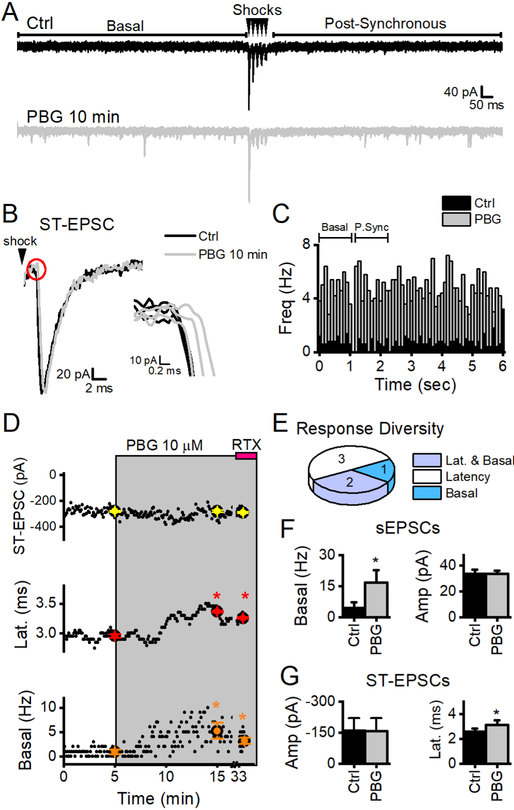Figure 7.
5-HT3 activation increases spontaneous glutamate release from TRPV1- afferents. A, Two overlaid sweeps from a single neuron receiving a TRPV1- afferent. Control (Ctrl, black) sweeps show low basal sEPSCs, characteristic of these afferents. Note that even with STEPSCs present, there is not an increase in post-synchronous events and hence no asynchronous release. After 10 minutes of PBG (10 μm, grey traces), basal sEPSC events have increased 3-fold (p < 0.01, KS test). B, Single traces of the first ST-EPSC in Ctrl and PBG are overlaid and illustrate that even with pronounced effect on sEPSCs, there was no effect on the amplitude of evoked glutamate release (p = 0.3, t test). The right panel expands the onset of the ST-EPSC outlined by the red circle. Three traces in Ctrl have near identical latencies that progressively get longer with PBG exposure (p < 0.01, t test). C, Overlaid histograms with events in 100 ms bins for each 6 sec sweep across two minutes (20 sweeps total). Note again that basal rates are equivalent to post-synchronous glutamate release. D, Diary plots of individual data points (black dots) are overlaid with data points that represent the mean ± SEM from 2 minutes in each condition (colored point with error bars). An asterisk marks significant differences from Ctrl (t test, p < 0.05). These plots illustrate a significant shift in latency and an increase in the number of basal events. Lack of an RTX (pink bar) response confirms this afferent as TRPV1-. E, PBG caused a 4 fold increase in basal sEPSC frequency (paired t test, p = 0.03) with no change in amplitudes (p = 0.9, paired t test) across responsive neurons (n = 3), indicating a presynaptic location of 5-HT3Rs. F, TRPV1- afferents had similar response diversity profiles as afferents with TRPV1. The most prominent response to PBG was a shift in latency (n = 5/6). G, Similar to TRPV1+ afferents, there was no change in ST-EPSC amplitudes (p = 0.7, n = 3, paired t test) with significant shifts in latency (p = 0.04, paired t test, n = 5).

